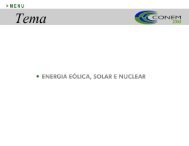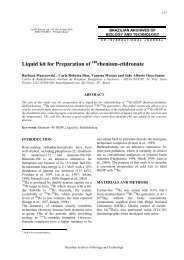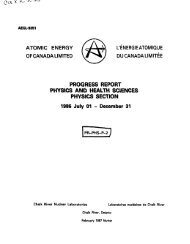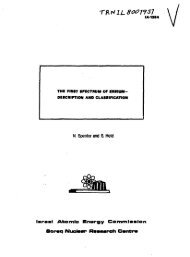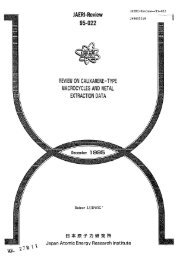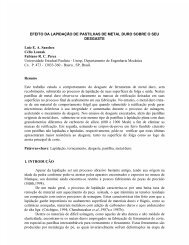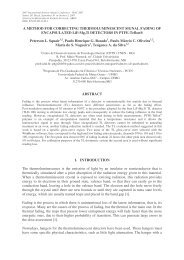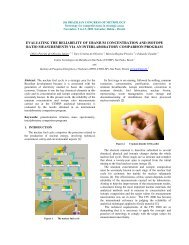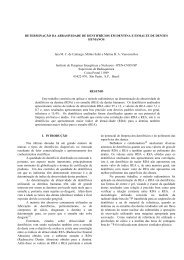Suppression of the slow component of BaF2 crystal by ... - Ipen
Suppression of the slow component of BaF2 crystal by ... - Ipen
Suppression of the slow component of BaF2 crystal by ... - Ipen
You also want an ePaper? Increase the reach of your titles
YUMPU automatically turns print PDFs into web optimized ePapers that Google loves.
1 . Introduction<br />
* Corresponding author .<br />
Nuclear Instruments and Methods in Physics Research A 353 (1994) 33-36<br />
<strong>Suppression</strong> <strong>of</strong> <strong>the</strong> <strong>slow</strong> <strong>component</strong> <strong>of</strong> <strong>BaF2</strong> <strong>crystal</strong><br />
<strong>by</strong> introduction <strong>of</strong> SrF2 and MgF2 <strong>crystal</strong>s<br />
M.M . Hamada a°*, Y . Nunoya b , S . Sakuragui `, Shinzou Kubota b<br />
Pure <strong>BaF2</strong> <strong>crystal</strong> has been widely applied as a scintillation<br />
material because <strong>of</strong> its high density, high radiation<br />
resistance and good time resolution due to <strong>the</strong> fast <strong>component</strong><br />
(< 1 ns) appearing in <strong>the</strong> emission bands around 220<br />
nm and 195 nm [1-6] . This fast <strong>component</strong>s luminescence<br />
is called Auger-free luminescence [4] or cross-luminescence<br />
[2], and it is attributed to <strong>the</strong> radioactive recombination<br />
<strong>of</strong> <strong>the</strong> F-2p valence band electrons with <strong>the</strong> outmostholes<br />
<strong>of</strong> <strong>the</strong> Bat' 5p core band.<br />
However, in addition to <strong>the</strong> fast <strong>component</strong>, <strong>BaF2</strong><br />
<strong>crystal</strong> has a <strong>slow</strong> <strong>component</strong> at 300 nm with a decay time<br />
<strong>of</strong> about 700 ns, which causes deterioration <strong>of</strong> <strong>the</strong> time<br />
resolution <strong>of</strong> <strong>the</strong> high counting rate [5,6] . This <strong>slow</strong> <strong>component</strong><br />
is attributed to <strong>the</strong> radioactive decay <strong>of</strong> self-trapped<br />
excitons formed <strong>by</strong> <strong>the</strong> excitons or <strong>the</strong> recombination<br />
process <strong>of</strong> <strong>the</strong> electrons in <strong>the</strong> conduction band with <strong>the</strong><br />
holes in <strong>the</strong> valence band [5,6] . In a pure <strong>BaF2</strong> <strong>crystal</strong><br />
approximately 80% <strong>of</strong> <strong>the</strong> light output occurs in <strong>the</strong> <strong>slow</strong><br />
<strong>component</strong> [8] . The suppression <strong>of</strong> <strong>the</strong> <strong>slow</strong> <strong>component</strong> is,<br />
<strong>the</strong>refore, a crucial key when applying this <strong>crystal</strong> to high<br />
counting rate experiments in fields such as high energy<br />
physics [5] and nuclear medicine [4]. There have been<br />
a IDEN-CNEN/SP, Trav. R 400 Cidade Unwersit6ria, Sdo Paulo, Brazil<br />
b Rikkyo University, 3 Nisht Ikebukuro, Toshema, Tokyo, Japan<br />
` Union Material Inc., Tone-Machi, Kitasoma, Ibaraki 270-12, Japan<br />
Abstract<br />
The emission spectrum, <strong>the</strong> time dependence <strong>of</strong> <strong>the</strong> luminescence, <strong>the</strong> light output, <strong>the</strong> excitation and <strong>the</strong> reflectance<br />
spectra have been measured for pure <strong>BaF2</strong> <strong>crystal</strong>, for <strong>BaF2</strong> : Sr <strong>crystal</strong>s with Sr 2+ concentrations <strong>of</strong> 2 and 5 mol% and for<br />
<strong>BaF2</strong> : MgF2 <strong>crystal</strong> with a mole mixing ratio <strong>of</strong> 1 : 2 . The measurements have been made <strong>by</strong> using synchrotron orbital<br />
radiation and high-energy electrons produced <strong>by</strong> gamma-rays . It is shown that <strong>the</strong> <strong>BaF2</strong> , <strong>BaF2</strong> : Sr and <strong>BaF2</strong> : MgF2 <strong>crystal</strong>s<br />
have a fast <strong>component</strong> luminescence with decay times around 0.90 ns . The <strong>slow</strong> and fast <strong>component</strong>s luminescence <strong>of</strong> <strong>the</strong><br />
<strong>BaF2</strong> <strong>crystal</strong> are suppressed <strong>by</strong> <strong>the</strong> introduction <strong>of</strong> Sr 2+ and Mg t+ ions . It is, however, clearly seen that <strong>the</strong> suppression <strong>of</strong><br />
<strong>the</strong> <strong>slow</strong> <strong>component</strong> is more effective than that <strong>of</strong> <strong>the</strong> fast <strong>component</strong>, especially in <strong>the</strong> <strong>BaF2</strong> : MgF2 <strong>crystal</strong> . The Sr 2+ and<br />
Mg t+ ions act as electron trapping centers, preventing <strong>the</strong> formation <strong>of</strong> self-trapped excitons <strong>by</strong> electron-hole pairs, that is<br />
<strong>the</strong> <strong>slow</strong> <strong>component</strong> .<br />
0168-9002/94/$07 .00 © 1994 Elsevier Science B.V . All rights reserved<br />
SSDI0168-9002(94)00837-X<br />
NUCLEAR<br />
INSTRUMENTS<br />
& METHODS<br />
IN PHYSICS<br />
RESEARCH<br />
Section A<br />
several attempts to reduce <strong>the</strong> <strong>slow</strong> <strong>component</strong> <strong>by</strong> introduction<br />
<strong>of</strong> a La, Cc <strong>component</strong> into <strong>the</strong> <strong>BaF2</strong> <strong>crystal</strong><br />
[5,6,8,9] .<br />
In <strong>the</strong> present work, <strong>the</strong> authors have focused <strong>the</strong><br />
research on a group <strong>of</strong> <strong>BaF2</strong>-based <strong>crystal</strong>s, composed <strong>of</strong><br />
<strong>BaF2</strong> and MgF2 with a mole mixing ratio <strong>of</strong> 1 :2 and<br />
<strong>BaF2</strong> : Sr with Sr 2+ concentrations <strong>of</strong> 2 mol% and 5<br />
mol% . Since it is well known that <strong>the</strong> MgF2 <strong>crystal</strong> has no<br />
luminescence under ionizing charged particle excitation<br />
[10], suppression <strong>of</strong> <strong>the</strong> <strong>slow</strong> <strong>component</strong> luminescence in<br />
<strong>the</strong> <strong>BaF2</strong> : MgF2 <strong>crystal</strong> is, <strong>the</strong>refore, expected . On <strong>the</strong><br />
o<strong>the</strong>r hand, SrF2 <strong>crystal</strong> has a <strong>slow</strong> <strong>component</strong> at 4.3 eV<br />
with a decay time <strong>of</strong> 900 ns [12], and <strong>the</strong> band gap-energy<br />
(11.6 eV) <strong>of</strong> SrF2 [11] is almost similar to <strong>the</strong> one <strong>of</strong> <strong>BaF2</strong><br />
(11.0 eV). Thus one could expect that <strong>the</strong> number <strong>of</strong><br />
electron-hole pairs produced <strong>by</strong> self-trapped excitons in<br />
<strong>BaF2</strong> : Sr <strong>crystal</strong> should not manifest any significant difference<br />
from that in pure <strong>BaF2</strong> <strong>crystal</strong>, unless ano<strong>the</strong>r effect<br />
can interfere in <strong>the</strong> production <strong>of</strong> <strong>the</strong> electron-hole pair .<br />
To ascertain <strong>the</strong>se expectations systematic measurements<br />
including <strong>the</strong> emission spectra, <strong>the</strong> time dependences<br />
<strong>of</strong> <strong>the</strong> luminescence, <strong>the</strong> light outputs and <strong>the</strong><br />
photoexcitation spectra and reflectance spectra for <strong>the</strong><br />
above <strong>crystal</strong>s were made . The results show that <strong>the</strong> <strong>slow</strong><br />
<strong>component</strong>s are suppressed <strong>by</strong> introducing MgF2 and SrF2 .<br />
Although a decrease <strong>of</strong> <strong>the</strong> fast <strong>component</strong> is also induced,<br />
<strong>the</strong> suppression <strong>of</strong> <strong>the</strong> <strong>slow</strong> <strong>component</strong> is more effective<br />
than that <strong>of</strong> <strong>the</strong> fast <strong>component</strong> .<br />
Ila . SCINTILLATION DETECTORS
34<br />
2 . Experimental methods<br />
M.M. Hamada et al. /Nucl. Instr . and Meth to Phys. Res . A 353 (1994) 33-36<br />
As <strong>the</strong> detailed experimental procedure has been described<br />
in Ref. [6], a brief description is given here . The<br />
<strong>BaF2</strong> , BaFZ : Sr and <strong>BaF2</strong> : MgF2 <strong>crystal</strong>s used in <strong>the</strong> present<br />
work were grown from <strong>the</strong> melt <strong>by</strong> <strong>the</strong> vertical<br />
Bridgman method using a graphite crucible . The starting<br />
powder for <strong>the</strong>se <strong>crystal</strong>s were <strong>of</strong> suprapure grade and<br />
purchased from E . Merck .<br />
The relative light output <strong>of</strong> <strong>the</strong> fast <strong>component</strong> <strong>of</strong> <strong>the</strong><br />
BaF,-based <strong>crystal</strong>s under irradiation <strong>of</strong> 662 keV gammarays<br />
from a 137 Cs source were measured with a UV<br />
sensitive quartz photomultiplier (Hamamatsu R1668) . The<br />
output signals from <strong>the</strong> photomultiplier were shaped with a<br />
resistance capacitance (RC) network having an RC clipping<br />
time constant <strong>of</strong> about 5 ns . The output pulses were<br />
sent through a fast preamplifier and a main amplifier and<br />
were submitted to a multichannel analyzer for pulse height<br />
analysis .<br />
The emission spectra and <strong>the</strong> time characteristics <strong>of</strong> <strong>the</strong><br />
luminescence from <strong>the</strong> <strong>crystal</strong>s were measured <strong>by</strong> employing<br />
time resolved spectroscopy using <strong>the</strong> single photon<br />
counting technique . A BaF, scintillator (about 2 X 2 X 3<br />
cm 3) and <strong>the</strong> sample <strong>crystal</strong> were simultaneously excited<br />
<strong>by</strong> correlated 511 keV gamma-rays from a 22 Na source . A<br />
UV sensitive photomultiplier (Hamamatsu Photonics,<br />
H2431QX) coupled to <strong>the</strong> <strong>BaF2</strong> scintillator generates<br />
zero-time signals and its outputs were used as start pulses<br />
for <strong>the</strong> time-to-amplitude converter . The delayed luminescence<br />
photons from <strong>the</strong> sample <strong>crystal</strong> were monochromatized<br />
with a monochromator (Shimadzu Bausch & Lomb)<br />
detected with a UV sensitive micro-channel-plate photomultiplier<br />
(Hamamatsu Photonics, R2809U-01) and its outputs<br />
were used as a stop for <strong>the</strong> time-to-amplitude converter<br />
. The pulses <strong>of</strong> <strong>the</strong> time-to-amplitude converter were<br />
fed into a multichannel analyzer where <strong>the</strong> decay curve<br />
was accumulated at a given wavelength <strong>of</strong> <strong>the</strong> emission .<br />
The emission spectra <strong>of</strong> <strong>the</strong> <strong>crystal</strong>s under investigation<br />
were measured <strong>by</strong> counting <strong>the</strong> numbers <strong>of</strong> <strong>the</strong> stop pulses<br />
at various wavelengths <strong>of</strong> luminescence in a common<br />
accumulation time.<br />
Table 1<br />
Decay times for <strong>the</strong> fast and <strong>slow</strong> <strong>component</strong>s . The ratios 1, /I:<br />
<strong>of</strong> <strong>the</strong> intensity <strong>of</strong> <strong>the</strong> T, decay <strong>component</strong> and T, decay <strong>component</strong><br />
are also summarized<br />
Crystal Decay time (ns) I, /IZ<br />
Fast <strong>component</strong> Slow <strong>component</strong><br />
at - 5.8 eV at - 4.2 eV<br />
( - 210 rim) ( - 300 rim)<br />
T, TZ<br />
<strong>BaF2</strong> 0.90±0.06<br />
BaF, :Sr(2%) 0.89±0.05<br />
330±30 670±60 0.44±0.10<br />
300±40 680±70 0.30±006<br />
BaF, :Sr(5%) 0.87±0.05 150±20 700+70 015±0.03<br />
BaFZ . MgF, 0.89+0.04<br />
To obtain complementary information, <strong>the</strong> photoexcitation<br />
and reflectance spectrum were measured <strong>by</strong> using <strong>the</strong><br />
synchrotron orbital radiation (SOR) at <strong>the</strong> Institute for<br />
Solid State Physics, Tokyo University . A surface <strong>of</strong> <strong>the</strong><br />
<strong>crystal</strong> to be studied was excited to <strong>the</strong> monochromatized<br />
UV photons with a normal angle . The luminescence photons<br />
emitted from <strong>the</strong> <strong>crystal</strong> were monochromatized and<br />
were detected with a quartz window photomultiplier . The<br />
photoexcitation spectra were measured as a function <strong>of</strong> <strong>the</strong><br />
excitation photon energy . The reflectance spectra were also<br />
obtained <strong>by</strong> measuring <strong>the</strong> intensity <strong>of</strong> reflected photon<br />
signals detected with a photomultiplier (Hamamatsu Photonics,<br />
R105) coated with a thin layer <strong>of</strong> sodium salicylate .<br />
3. Results and discussion<br />
Table 1 summarizes <strong>the</strong> values <strong>of</strong> <strong>the</strong> fast and <strong>slow</strong><br />
decay times <strong>of</strong> <strong>the</strong> BaFZ , BaF, : Sr(2%), BaFZ : Sr(5%) and<br />
BaFZ : MgF2 <strong>crystal</strong>s . No significant difference was observed<br />
in <strong>the</strong> decay time <strong>of</strong> <strong>the</strong> fast <strong>component</strong> among four<br />
<strong>crystal</strong>s, i .e . <strong>the</strong> decay times were found to be about 900<br />
ns . The <strong>slow</strong> <strong>component</strong> luminescence appears to contain<br />
two different contributions with decay times rl and 'r2 .<br />
Although no <strong>crystal</strong>s showed any "r2 difference in relation<br />
to BaF, <strong>the</strong> determined value <strong>of</strong> T, for <strong>the</strong> <strong>BaF2</strong> : Sr (5%)<br />
<strong>crystal</strong> was found to be nearly half <strong>of</strong> <strong>the</strong> BaF, <strong>crystal</strong> .<br />
The relatives intensities <strong>of</strong> <strong>the</strong> two contributions <strong>of</strong> <strong>the</strong><br />
<strong>slow</strong> <strong>component</strong> are also shown in Table 1 . The decay<br />
time for <strong>the</strong> <strong>slow</strong> <strong>component</strong> in <strong>the</strong> BaF, : MgF2 <strong>crystal</strong><br />
could not be obtained, since <strong>the</strong> emission intensity was not<br />
as intense as those in <strong>the</strong> <strong>BaF2</strong> and <strong>the</strong> BaFZ : Sr Crystals .<br />
The relative light output <strong>of</strong> <strong>the</strong> fast <strong>component</strong>s was<br />
measured to be 1 .0, 0.41, 0.27 and 0.22 for <strong>the</strong> <strong>BaF2</strong> ,<br />
<strong>BaF2</strong> : Sr and <strong>BaF2</strong> : MgF2 <strong>crystal</strong>s, respectively, under <strong>the</strong><br />
excitation <strong>of</strong> high-energy electrons generated <strong>by</strong> 662 keV<br />
gamma-rays . Fig . 1 shows <strong>the</strong> emission spectra for four<br />
<strong>crystal</strong>s under high-energy electron excitation generated <strong>by</strong><br />
511 keV gamma-rays . The intensities at <strong>the</strong> maximum<br />
values <strong>of</strong> <strong>the</strong> fast <strong>component</strong> luminescence at around 5.8<br />
eV (214 rim) were scaled <strong>by</strong> using <strong>the</strong>ir relative light<br />
output ratios indicated above. It is to be noted here that <strong>the</strong><br />
spectrum width <strong>of</strong> <strong>the</strong> fast <strong>component</strong> for <strong>the</strong> <strong>BaF2</strong> : MgFZ<br />
<strong>crystal</strong> is 4.2 eV, which is larger than those (2 .7 eV) from<br />
<strong>the</strong> BaF, and <strong>BaF2</strong> : Sr <strong>crystal</strong>s . These results suggest that<br />
<strong>the</strong> valence band width in <strong>the</strong> <strong>BaF2</strong> : MgF2 <strong>crystal</strong> is about<br />
1.5 eV wider than those in <strong>the</strong> BaFZ and BaFZ : Sr <strong>crystal</strong>s<br />
[4] .<br />
The <strong>slow</strong> <strong>component</strong> peaks were located around 4.2 eV<br />
(300 rim) for four <strong>crystal</strong>s, while <strong>the</strong> fast <strong>component</strong> peaks<br />
were located at 5.9 eV (210 rim) for <strong>the</strong> <strong>BaF2</strong> and BaF, : Sr<br />
<strong>crystal</strong>s and at 5.7 eV (217 rim) for <strong>the</strong> BaF, :MgF2<br />
<strong>crystal</strong> . Table 2 compiles <strong>the</strong> relative light outputs <strong>of</strong> <strong>the</strong><br />
fast and <strong>slow</strong> <strong>component</strong>s toge<strong>the</strong>r with <strong>the</strong> ratios <strong>of</strong> <strong>the</strong><br />
fast <strong>component</strong> intensity to <strong>the</strong> <strong>slow</strong> <strong>component</strong> intensity<br />
for four <strong>crystal</strong>s .
-<br />
0<br />
. NNÉ<br />
w<br />
[.FA<br />
MM Hamada et al. /Nucl. Instr. and Meth in Phys . Res. A 353 (1994) 33-36<br />
Photon Energy (eV)<br />
Fig . 1 . Emission spectra <strong>of</strong> <strong>the</strong> <strong>BaF2</strong> , <strong>BaF2</strong> : Sr (5%) and<br />
BaFZ : MgF2 <strong>crystal</strong>s under high-energy electrons excitation. Solid<br />
curve : total emission spectra . Dotted curve : fast emission spectra .<br />
Dashed curve : <strong>slow</strong> emission spectra.<br />
The experimental results <strong>of</strong> Fig . 1 shows that <strong>the</strong> fast<br />
and <strong>slow</strong> <strong>component</strong>s decrease in <strong>the</strong> BaF Z : MgF2 <strong>crystal</strong> .<br />
It is important to pay attention to <strong>the</strong> fact that <strong>the</strong> <strong>slow</strong><br />
<strong>component</strong> is more effectively suppressed than that <strong>of</strong> <strong>the</strong><br />
fast <strong>component</strong> .<br />
Figs. 2a, 2b and 2c show <strong>the</strong> photoexcitation spectra for<br />
<strong>the</strong> fast and <strong>slow</strong> <strong>component</strong>s luminescence and reflectance<br />
spectra <strong>of</strong> <strong>the</strong> <strong>BaF2</strong> , BaF Z : Sr(5%) and<br />
<strong>BaF2</strong> : MgFZ <strong>crystal</strong>s, respectively. The threshold energies<br />
Table 2<br />
Relative light outputs <strong>of</strong> <strong>the</strong> fast and <strong>slow</strong> <strong>component</strong>s <strong>of</strong> <strong>crystal</strong>s .<br />
The ratio F/S <strong>of</strong> <strong>the</strong> fast <strong>component</strong> intensity to <strong>the</strong> <strong>slow</strong><br />
<strong>component</strong> intensity are also indicated. Experimental uncertainties<br />
are 15%<br />
Crystal Relative light output (%) FIS<br />
Fast <strong>component</strong><br />
at - 5 .8 eV<br />
(-210nm)<br />
Slow <strong>component</strong><br />
at - 4.2 eV<br />
(-300nm)<br />
<strong>BaF2</strong> 100 357 0.28<br />
<strong>BaF2</strong> : Sr(2%) 41 85 0.48<br />
<strong>BaF2</strong> : Sr(5%) 27 45 0.60<br />
<strong>BaF2</strong> : MgF2 22 8 2.70<br />
<strong>BaF2</strong><br />
<strong>BaF2</strong> :MgFz<br />
Photon Energy (eV)<br />
Fig. 2 . Excitation spectra for fast <strong>component</strong> (dotted lines labeled<br />
2) and <strong>slow</strong> <strong>component</strong> (lines labeled 1) from BaF Z , <strong>BaF2</strong> : Sr(5%)<br />
and <strong>BaF2</strong> : MgF2 . Reflectance spectra are shown <strong>by</strong> lines labeled<br />
3 . The peak positions <strong>of</strong> <strong>the</strong> excitons are indicated <strong>by</strong> F and those<br />
for <strong>the</strong> core excitons <strong>by</strong> A and B . The band gap positions are also<br />
indicated <strong>by</strong> Eg .<br />
<strong>of</strong> <strong>the</strong> fast <strong>component</strong> luminescence are located at 18 .0 ±<br />
0 .2 eV, 18 .0 ± 0 .2 eV and 19 .3 ± 0 .2 eV for BaFZ ,<br />
<strong>BaF2</strong> : Sr(5%) and <strong>BaF2</strong> : MgFZ <strong>crystal</strong>s, respectively .<br />
As it can be seen from <strong>the</strong> <strong>slow</strong> <strong>component</strong> photoexcitation<br />
spectrum for <strong>the</strong> BaFZ : MgFZ <strong>crystal</strong>, this luminescence<br />
was efficiently excited at <strong>the</strong> excitation photon<br />
energy <strong>of</strong> around 10 .0 eV, but no significant luminescence<br />
was observed at an excitation photoenergy higher than<br />
11 .0 eV . This feature apparently contrasts to those <strong>of</strong> <strong>the</strong><br />
excitation spectra for BaFZ and BaFZ : Sr <strong>crystal</strong>s in which<br />
significant luminescence is excited around <strong>the</strong> excitation<br />
photon energy <strong>of</strong> both <strong>the</strong> exciton and <strong>the</strong> valence-band<br />
excitations .<br />
Intensive peaks <strong>of</strong> reflectance spectra for <strong>the</strong> BaFZ and<br />
<strong>BaF2</strong> : Sr <strong>crystal</strong>s at 9 .8 eV are assigned to <strong>the</strong> exciton<br />
energy (F). For <strong>the</strong> <strong>BaF2</strong> : MgFZ <strong>crystal</strong>, two peaks at<br />
10 .0 eV and 11 .0 eV are observed in <strong>the</strong> exciton region .<br />
The peak appearing at 11 .0 eV is attributed to <strong>the</strong> exciton<br />
creation which is 1 .0 eV higher than that <strong>of</strong> <strong>the</strong> pure <strong>BaF2</strong><br />
<strong>crystal</strong>, <strong>by</strong> considering <strong>the</strong> increase <strong>of</strong> band-gap energy Eg<br />
(11 .9 eV) for <strong>the</strong> <strong>BaF2</strong> : MgFZ <strong>crystal</strong> compared to that<br />
(11 .1 eV) for <strong>the</strong> <strong>BaF2</strong> <strong>crystal</strong> [4] . The first peak at 10 .0<br />
eV, which is almost equal to <strong>the</strong> 9 .8 eV in <strong>the</strong> <strong>BaF2</strong><br />
<strong>crystal</strong>, is most likely due to <strong>the</strong> exciton creation originated<br />
Ila . SCINTILLATION DETECTORS<br />
35
36<br />
<strong>by</strong> <strong>the</strong> BaF, <strong>crystal</strong>, which consists in <strong>the</strong> impurity formed<br />
in <strong>the</strong> <strong>crystal</strong> .<br />
Therefore, <strong>the</strong>se results suggest that <strong>the</strong> <strong>slow</strong> lumines-<br />
cence observed in <strong>the</strong> BaF, : MgF, <strong>crystal</strong> is attributed to<br />
<strong>the</strong> radioactive decay <strong>of</strong> <strong>the</strong> self-trapped exciton formed<br />
uniquely from <strong>the</strong> exciton originating from <strong>the</strong> impurity <strong>of</strong><br />
<strong>the</strong> <strong>BaF2</strong> <strong>crystal</strong> present in <strong>the</strong> <strong>BaF2</strong> : MgF, <strong>crystal</strong> . It is<br />
expected, <strong>the</strong>refore, that <strong>the</strong> <strong>slow</strong> <strong>component</strong> is totally<br />
suppressed in a perfect <strong>BaF2</strong> : MgF2 <strong>crystal</strong> .<br />
Figs . 2a and 2b show <strong>the</strong> photoexcitation spectra and<br />
reflectance spectra for <strong>the</strong> <strong>BaF2</strong> and <strong>BaF2</strong> : Sr <strong>crystal</strong>s .<br />
Since <strong>the</strong>re are similarities between <strong>the</strong> spectra from <strong>the</strong><br />
BaF, and those from <strong>the</strong> <strong>BaF2</strong> : Sr <strong>crystal</strong>, it is concluded<br />
that <strong>the</strong> Sr 21 ions introduction has little effect on <strong>the</strong><br />
resultant band structure for <strong>the</strong> <strong>BaF2</strong> : Sr <strong>crystal</strong> . However,<br />
experimental results showed a considerable decrease in <strong>the</strong><br />
intensity <strong>of</strong> <strong>the</strong> <strong>slow</strong> <strong>component</strong> luminescence as it can be<br />
seen in Fig. 1 and Table 2 . Since <strong>the</strong> decay times <strong>of</strong> <strong>the</strong><br />
<strong>slow</strong> <strong>component</strong> <strong>of</strong> <strong>the</strong> <strong>BaF2</strong> : Sr <strong>crystal</strong> are almost similar<br />
to those from <strong>the</strong> <strong>BaF2</strong> <strong>crystal</strong>, it can be concluded that <strong>the</strong><br />
introduction <strong>of</strong> Sr 2+ ions does not affect <strong>the</strong> decay rate <strong>of</strong><br />
<strong>the</strong> self-trapped excitons . The probable explanation <strong>of</strong> <strong>the</strong><br />
intensity decrease is, <strong>the</strong>refore, that <strong>the</strong> Sr 2+ ions are<br />
acting as electron trapping centers preventing <strong>the</strong> electrons<br />
to recombine with <strong>the</strong> holes, resulting in <strong>the</strong> reduction <strong>of</strong><br />
<strong>the</strong> number <strong>of</strong> self-trapped excitons . Schotanus et al . have<br />
reported a similar decrease in <strong>the</strong> intensity <strong>of</strong> <strong>the</strong> <strong>slow</strong><br />
<strong>component</strong> in a La 3+ doped <strong>BaF2</strong> <strong>crystal</strong>, and have inter-<br />
preted it <strong>by</strong> <strong>the</strong> same mechanism [5] .<br />
4 . Summary<br />
M.M. Hamada et al. /Nucl. Instr. and Meth in Phys. Res . A 353 (1994) 33-36<br />
A difficulty was found in syn<strong>the</strong>sizing <strong>crystal</strong>s where<br />
<strong>the</strong> <strong>slow</strong> <strong>component</strong> was highly suppressed without a<br />
significant decrease in <strong>the</strong> fast <strong>component</strong> intensity, which<br />
was one <strong>of</strong> <strong>the</strong> goals <strong>of</strong> <strong>the</strong> present work. However, it can<br />
be said that <strong>the</strong> newly syn<strong>the</strong>sized <strong>BaF2</strong> : MgF2 <strong>crystal</strong><br />
manifested <strong>the</strong> promising enhancement <strong>of</strong> <strong>the</strong> fast compo-<br />
nent at <strong>the</strong> expense <strong>of</strong> partially quenching <strong>the</strong> original<br />
luminescence intensity . On <strong>the</strong> o<strong>the</strong>r hand, for applications<br />
in high energy physics, a fast response is more important<br />
than high light output .<br />
Acknowledgements<br />
One <strong>of</strong> authors (M.M .H .) would like to express her<br />
gratitude to Rikkyo University for <strong>the</strong> research fellowship<br />
and to IPEN-CNEN/SP for <strong>the</strong> opportunity and support<br />
given in order to accomplish this research . The authors are<br />
grateful to staff <strong>of</strong> <strong>the</strong> Synchrotron Orbital Radiation Facil-<br />
ities from Tokyo University for support during <strong>the</strong> experi-<br />
ments with VUV photons .<br />
References<br />
Yu .M . Aleksandrov, V.N Makhov, P.A . Rodny, T.I .<br />
Syreishchikova and M.N . Yakimenko, Sov . Phys . Solid State<br />
26 (1984) 1734 .<br />
[2] J.L . Jansons, V.L . Krumins, Z.A . Rachiko and J.A. Valbis,<br />
Phys . Status Solidi 144 (1987) 835 .<br />
M. Itoh, S . Hashimoto, S . Sakuragui and S. Kubota, Solid<br />
State Commun . 65 (1988) 523 .<br />
[4] S . Kubota, M. Rob, J Ruan, S . Sakuragui and S . Hashimoto,<br />
Phys . Rev . Lett . 60 (1988) 2319.<br />
P . Schotanus, P. Dorenbos, C.W.E. Van Eijik and R.W .<br />
Hollander, IEEE Trans. Nucl. Sci . NS-36 (1989) 162 .<br />
[6] M.M . Hamada, Nucl . Instr . and Meth. A 340 (1994) 524 .<br />
[7] M.N . Kabler, R.T . Willians, Phys . Rev . B 18 (1976) 725 .<br />
[8] C.L . Woody and D.F. Anderson, Nucl . Instr . and Meth. A<br />
265 (1988) 291 .<br />
P . Dorenbos, R. Visser, C.W .E . van Eijik, J Valbis and<br />
N.M . Khaidukov, IEEE Trans . Nucl. Sci . NS-39 (1992) 506 .<br />
[10] R.T . Willians, C.L Marquardt, J.W. Willians and M.N .<br />
Kabler, Phys . Rev . B 15 (1977) 5003 .<br />
[11] R.T . Poole, J . Szajman, R.C.G . Leckey, J.G . Jenkin and J .<br />
Liesegang, Phys . Rev . B 12 (1975) 5872.<br />
[12] Kubota, J . Roan, M. Itoh, S . Hashimoto and S . Sakuragur,<br />
Nucl . Instr and Meth. A 289 (1990) 253 .




